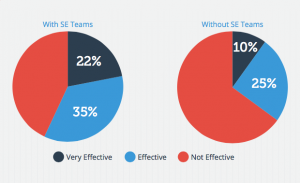Freelancers will certainly have a decisive role to play in the labor market as businesses wade back toward post-pandemic normalcy. 2019 survey data from the hiring platform giant Upwork found respondents identifying talent scarcity and access to in-demand skills as core challenges for hiring.
Subsequent findings from that survey in 2020, however, marked an important paradigm shift: Nearly half of all reporting organizations had implemented hiring freezes, and another 39% had either already laid off employees or expected to do so in the future. Likewise, employers anticipated by then that only 53% of their laid-off workforce would be rehired, while only 10% of businesses reported a hiring increase in light of the pandemic.
So what does all of this mean for your business? Whatever your hiring strategy, every operation eventually has to reckon with how to scale properly — whether to grow internal teams and when to outsource. Know that where there is successful expansion, your business will likely find itself having to outsource at least some of its nonessential functions. There are considerations to weigh between both moves (which we’ll cover here) so that flexible talent has the place it needs in your business scaling strategy.
Flexible Staffing Solutions by Talent Type
Although it might be tempting to take an on-demand hiring approach to reduce company overhead through flexible talent, bringing on the right out-of-house talent should be a front-and-center consideration when it comes to your business operations and strategy. Two of the more common types of talent include:
- Freelancers: Known also as “gig workers,” all freelancers work on a contract basis, and many prefer it that way. Quality talent from this pool brings valuable and reliable expertise to your operation, and you only need to tap freelancers when you have project work. You might also consider whether permalancers or interns need to be part of your agency strategy.
- White-label services: Essentially, this refers to a service that you rebrand to make it appear as your own. Oftentimes, you will have a customer who wants a service that is not part of your current service offerings, for instance. In this situation, you can outsource the work to white-label partners who will allow you to put your own name on the service. Overall, white-label partners can provide this service without disruption to your current operations.
Even though the benefits of hiring a freelancer are plenty, intentional hiring must always be central to your business operations and strategy, rather than reaching for the cheapest staffing option. Knowing which talent types can do what for your company will count in a big way toward that end.
The Benefits of Outsourcing (Beyond Simple Cost-Cutting)
It is more than just effective overhead management that agencies stand to gain from a more flexible staffing approach. The common reflex among agencies is to adjust their headcount according to business opportunities as they exist in the moment — or even in the quarter.
Although wide, impacting decisions need to be made in real time, this is not a star to steer by with any regularity. As a strategy, hiring and firing in waves and troughs encourages a “demoralizing, disruptive cycle of hiring and layoffs,” notes staffing agency Robert Half.
With flexible staffing built into agency strategy, you will still see full-time employees devoted to the more perennial parts of the operation. At the same time, you’ll have outside talent that is equipped to pivot when the need is there.
An additional benefit of hiring freelancers includes more ground for growth. Labor tends to be among the greatest cost for agencies, and a reduction in such expenses leaves an agency lean, agile, and well-positioned for growth. In peak periods, freelance staff will be there to manage demand, all while leaving space for key business decisions on how to bolster your operation at its core.
Other benefits include a better work-life balance for your employees. After all, this pandemic has brought with it no shortage of stressors to contend with both in and out of the office. Thus, it becomes doubly important that those working full time be given a healthy work-life balance, which is made possible by the extra help freelancers provide.
From Scale to Scope: A Model in Hollywood
In scaling the business, it helps to understand our economy as it once was (focusing on economies of scale, where per-unit cost lowers with higher production output) and what it is presently (an economy of scope). Many companies have refined their core competencies, choosing then to outsource the remainder of the work.
Hollywood studios provide an interesting model to examine. Studios were once managing their entire moviemaking process under one roof. Now, they outsource segments of the filmmaking process to experts they know will go above and beyond what they can do in-house. And by leveraging expertise for parts of the filmmaking process studios don’t have internally, they ensure a better product overall for the consumer.
Knowing When to Outsource
From a cost standpoint, outsourcing is a common tool to scale your business. It is also something you should be considering to manage overhead costs as you execute your growth plan. Outsourced talent allows you to match costs against fees to ensure your business is not overleveraged. The flip side to this is adding headcount too soon and not having enough work or funds to cover payroll.
Consider the four points below to determine whether you should be looking to outsource work under your own roof:
1. Client-first approach: It makes sense to outsource what isn’t central to your service model. In the field of advertising, creative agencies routinely outsource work such as commercial video production to studios or print collateral to print shops.
Remember: Agencies are in the ideas business. They focus on creating the best idea for their customer and should be channel-agnostic as to how that message reaches their audience (unless you specialize in a specific channel like an SEO firm). However, a creative agency that owned a print shop or had a print department would somehow always find a way to recommend that as a solution to its client. Similarly, if you only had a hammer in your tool box, every problem would look like a nail. Of course, different clients will require different solutions — making it all the more important to stay flexible.
2. Out-of-house talent needs: Let’s face it: With your clients who deliver more than 15% of your net gross profit, you have a front-row view into their needs and challenges. You propose solutions for those challenges, though you don’t always have the right talent immediately on-hand. Being able to tap the right talent for a project as needed means that clients get the service they need without your agency having to bear excessive overhead.
3. Pivots during slowdowns: There will be less of a pace at times, be it from losing a major client, economic downturn, or otherwise. In these periods, it’ll be essential to outsource work where necessary while working to reduce overhead and incur costs only where there’s revenue to match.
4. In-house expansion: You’ll want to do this when you lack the key internal talent needed to reach your strategic goals. Whatever your core competencies, these are the personnel you’ll need to be seen as the expert you are. For both clients and prospects alike, they’re your proof-point for your expert status.
When planning your headcount, you’ll want to understand your revenue-per-employee ratio. This is calculated by dividing net revenues for a certain period by the average number of employees in your company during that period. This ratio measures productivity and shows how much each employee is contributing to business growth. Labor-intensive companies like service-based businesses will have lower ratios compared to, say, a tech company.
This revenue-per-employee ratio is a good metric to add to your management dashboard, so use it to measure your performance at different points during your growth cycle and use it for comparison purposes with your competitors.
As employees often comprise your highest percentage of overhead, you’ll want an informed hiring strategy in place to ensure the impact your talent realizes within the organization is multiple times over the cost of employment.
Overall, how you plan for hiring has a great bearing on how your business performs. And a diversified, flexible staffing approach — having the right talent where you need them and when — will leave you and your business well-positioned for whatever challenges need meeting along the way.
Business & Finance Articles on Business 2 Community
(35)





